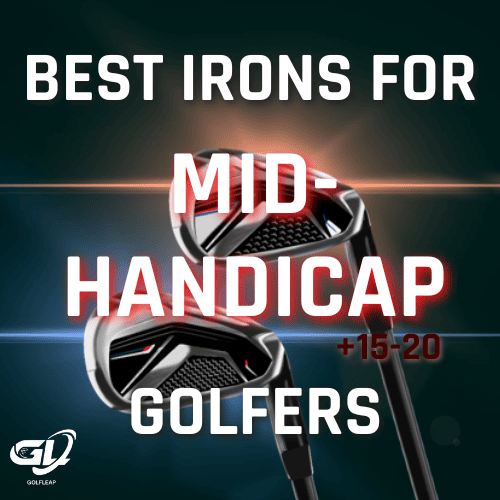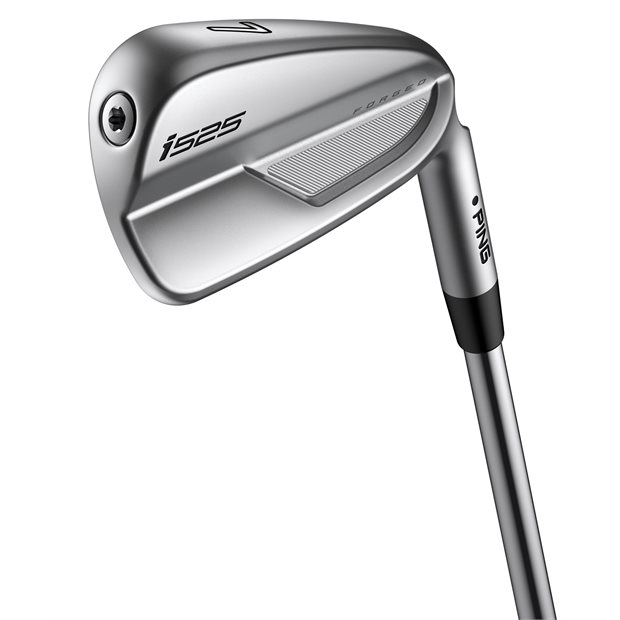Here are the 9 Best Irons for Mid Handicappers specifically for those between a 15-20 handicap.
With every major golf equipment manufacturer offering multiple iron models that promise to make your performance better, finding the perfect irons for your game as a 15 or 20–handicap golfer can feel like an overwhelming process.
Thankfully for you, as a former mid handicapper who’s now playing near-Scratch, I feel I can apply my decades of club testing experience to help you find what’ll take your golf game to the next level as I did mine!

Table of Contents
Best Irons for a Mid-Handicap Golfer
Mid-handicap irons are game improvement irons that are best suited for golfers playing between a 15-handicap and a 20-handicap. These irons are slightly more forgiving than a set of irons for a 10-handicap golfer where you start getting into the blade or semi-blade irons which are best suited for those playing between a 10 handicap and Scratch. That said, mid-handicap irons still enjoy a thinner-than-usual topline like the semi-blade while providing the necessary forgiveness a 15 or 20-handicap golfer needs. They’re the perfect balance between a player’s irons and your everyday beginner irons.
Game Improvement vs. Player Distance Irons: Which Is Better for a Mid handicap Golfer?
The short answer, Game Improvement, but don’t be discouraged. Manufacturers are going out of their way to create irons that go far and have higher spin rates off the club face, so your ball lands softly on the green.
Any of our highlighted irons are a mix of Game Improvement and Player Distance benefits and will minimize mishits, give you great distance and better feel, and help you get the lower scores you’re working towards.
4 Best Irons for 20 Handicap Golfers
Irons for a 20-handicap golfer will be more forgiving and have a slightly larger profile compared to a set of irons for a 15-handicap golfer. That said, if you’re a 15 handicap golfer, feel free to choose one of these irons if the extra profile and forgiveness are what you prefer.
1. Cobra AeroJet Irons (The Best Irons for a 20 Handicap Golfers)
Pros
- Truly effortless distance irons
- Sounds clean and crisp at impact thanks to new inserts and face design
- Thick enough to look forgiving without “game improvement” look
- Medium-large club head creates easy solid contact
- Two shaft options based on ball flight and individual strength
Cons
- Lofts are quite enhanced, making a PW a true 9-8 iron.
Cobra calls their new AeroJet irons “our most technologically advanced iron to-date,” and we strongly believe they’ll help every 20 handicap have more effortless distance and height to attack more greens with confidence.
Sitting just behind the club face is the new “PWR-BRIDGE Weighting” that uses a soft polymer filler to hold this weight for a better feel, sound, and 10% more face flexion for an added distance boost.
A forged “PWRSHELL” club face insert creates more flexibility in a greater area of the face for faster ball speeds and a higher launch on good shots and bad, while “H.O.T Face Technology” uses AI to create a variable thickness club face for controllable spin and ample speed.
Key Features:
- Cobras “most technologically advanced iron”
- Designed for more distance, height, and control
- Available with Arccos Smart Sensors for free
- Available in two sets (4-PW) or (4-Gap Wedge)
Shafts:
- KBS Tour Lite (Steel)
- KBS PGI 85/75/65 (Graphite)
2. Mizuno JPX 923 Forged Irons (Great for 20 Handicap That’s Getting Better)
Pros
- Looks like a “players iron” while performing like a forgiving iron
- Incredible bag appeal and overall appearance
- Mizuno irons feel uniquely smooth and confidence-inspiring at impact
Cons
- Fitting required to take advantage of shaft offerings
The Mizuno JPX 923 Forged irons are Mizunos newest generation of their most famous “JPX Forged” club line, and were created to look like a “player’s iron” while having the distance and forgiveness of a game improvement iron.
The 923 Forged iron heads get progressively longer and wider as the irons get longer, meaning you’ll feel equal levels of confidence regardless of which iron you’re swinging.
Mizuno irons are well known for their forged feel, but the new JPX 923 Forges 4- through 7-iron now have a wider hollow area behind the club face for added ball speed and distance. Lastly, Mizuno offers the 923 Forged irons with a golfer’s choice of 30 premium shafts, making a fitting crucial.
Key Features:
- Designed to be “thin and sleek yet highly powerful.”
- Hollow center for more ball speed and distance
- “V Chassis” Insert creates more forgiveness, a thinner overall look, and a better feel
- Scoring irons are smaller and more compact while long irons are larger and more forgivingly shaped
Shafts:
- Golfers’ choice of thirty (30!) premium shaft options in both Graphite and Steel
3. PING i525 Irons (PING’s Best Game Improvement Compact Iron for 20 handicap golfers)
Pros
- Sleek design with boosted perimeter weighting for forgiveness
- “Players” Shape/Look
- “Face Polymer” improves feel and sound while increasing ball speed
Cons
- “New-Age” appearance might not appeal to traditionalist golfers
The new forged PING i525 irons are designed to look like a “Players iron” while performing with incredible distance and forgiveness-boosting qualities.
For starters, the entire body and club face of the i525s is forged, but the inside has been hollowed out to increase face flexion for more speed, height, and distance on all shots.
“Extreme” Tungsten toe weights and shaft tips expand the already significant perimeter weighting for improved forgiveness, while the injected polymer behind the club face produces a clean sound and feel at impact.
Lastly, we especially love the addition of the new “Hydro Pearl 2.0” finish that repels water for more consistency, and the 4 added grooves per club face for more spin and control on all shots.
Key Features:
- “Extreme” Tungsten weights increase ball speed and reduce face-twist for improved accuracy
- Forged club face feels great and launches shots high and fast
- 4 extra grooves per face for more spin and consistency
- Compact look with forgiving use
Shafts:
- Project X IO (Steel)
- PING Alta CB Slate (Graphite)
4. Srixon ZX4 Mk II Irons (Most Forgiving Srixon Irons Perfect for 20 Handicap Players)
Pros
- “Tour V.T. Sole” helps maintain clubhead speed through impact
- Progressive grooves for more confident and controlled ball-striking throughout the set
- Forged face provides great vibrational feedback
Cons
- Premium price point
- Extra strong lofts
The Srixon ZX4 Mk II irons are Srixons most forgiving and distance-focused clubs they’ve ever created.
Behind the irons sleek appearance sits a premium forged face, a narrow topline, the most offset and the longest club head length from any Srixon iron to ultimately inspire confidence in every 15 handicapper.
“MainFrame Technology” is how Srixon describes the variable thickness pattern on the backside of the ZX4 Mk II irons. This technology repositions mass away from the face in the toe and sole for faster ball speeds and more consistency and forgiveness at the same time.
The famous “Tour V.T. Sole” prevents digging into the turf, and progressive grooves let players know they can strike every iron with the utmost confidence their shot will have appropriate spin.
Key Features:
- Designed for “maximum forgiveness plus powerful distance.”
- Winner of 2023 Golf Digest Hot List Gold Medal
- Great bag appeal and overall visual appearance
- Free Arccos Smart Sensors available
Shafts:
- KBS Tour Lite (Steel)
- UST Mamiya Recoil Dart 65 (Graphite)
4 Best Irons for 15 Handicap Golfers
While it might sound cliche, no two 15-handicap golfers will need exactly the same benefits from purchasing a new set of irons.
For this very reason, we were sure to include iron selections that cater toward more control, height, accuracy, workability, and overall feeling at impact to make sure every mid handicap has an iron option that excites them!
1. TaylorMade P790 2023 Iron Set (The Best Irons for a 15 Handicap Golfer)
Pros
- Much easier to control from added weight in the new 2023 model
- Oustanding looks in the bag and at address
- Flexible, ultra-thin face helps increase ball speed
- More explosive ball speed compared to the 2021 model
- Maintains straightness on mishits
- Delivers optimal distance with impressive launch angle
Cons
- More problematic for slower-swinging golfers to hit the long and mid irons
- Not as high forgiveness due to better workability
Sexy and forgiving, the 2023 P790 scores again with a golf improvement iron with decidedly player-distance visuals. The first-generation clubs were great performers for mid-handicappers, but TaylorMade contends the new P790s feel better than previous models.
It takes work to improve on perfection. Behind the ball, the topline is just thin enough, and the satin chrome brushed surface is eye candy. The muscle back design screams power and looks inviting to hit with just a hint of offset.
The big story is Speed Foam Air, which makes for less mass in the head, 3.5 grams per head, to be exact. The clubface is now 37.5% thinner, making for unmatched ball speed. Using Tungsten components, more weight goes to the perimeter of the club.
The sweet spot is nearly 60% bigger and more towards the centre than the original 2019 model and the tungsten weighting is moved closer to the toe, providing slightly better control compared to the 2021 model. No wonder the TaylorMade P790 is the best-selling club ever. Flies far and lands soft as a feather, just like you want. The P790 is not for scratch golfers but is ideal for improving players trying to break a 15 handicap.
It is not as strongly lofted as others in its class, making the club slightly more workable. The transfer of power from the club to the ball feels and sounds first-rate; consistent, uniform, and forgiving.
Key Features:
- Excellent quality and workability
- Compact profile with player-distance visuals while playing like an amazing improvement iron
- One of the most popular golf clubs ever made (for a good reason)
Shafts:
- True Temper Dynamic Gold (Steel)
- Mitsubishi Chemical MMT (Graphite)
Comparing the Stealth and the P790 by TaylorMade:
Comparing the P790 to the P770s, check our review here: P770 vs p790
2. Takomo Golf 201 Irons (Most Affordable Custom Irons for Mid Handicap-Scratch Golfer)
Pros
- Great set for a player to progress in skill with
- Great introductory custom set for a golfer looking for custom fitted irons
- High quality shaft options
- Unbelievable distance
Cons
- Only Steel shaft options
While Takomo isn’t the most well known golf club maker on our list, that doesn’t stop them from rivaling many of the best in forged golf club quality, appearance, and particularly price.
The Takomo 201 irons have a slight cavity back and were designed for control, speed, and forgiveness. The small milled cavity adds significant ball speed and additional mass for more playability on poor shots.
For roughly ⅓ of the price of premium competing brands, golfers will receive a top of the line forged iron that’ll add significant distance, feel, and control to their golf game.
To see the quality of these bad boys, we’ve covered one of its older brothers the Takomo Golf 101 iron review! Check it out!
Key Features:
- Affordable due to Takomo’s “Direct to Consumer” business model
- Forged iron look, feel, and performance at budget-friendly price
- Takomo Golf sponsors many famous YouTube golfers (relatable to young people)
Shafts:
- KBS Tour Lite R, S, XS (Steel)
- KBS Tour R, S, XS (Steel)
3. Titleist 620 CB Irons (Best “Players Looking” Cavity Back Irons)
Pros
- Arguably best appearance and “bag appeal” of every option on our list
- Tour player influenced sole design for easier turf interaction
- Trusted, older club head design with modern improvements
- Tons of shaft options making a custom fitting valuable
- Fully forged irons feel amazing at impact
Cons
- Unconfident ball strikers might not like the smaller scoring irons (PW-8)
The revamped “Classic Cavity-inspired” Titleist 620 CB irons are one of our top picks for golfers that are looking to break out of the mid handicapper category and shoot lower scores.
Inspired by their famous small cavity back generations of earlier irons, Titleist took amateur and PGA Tour player influences to make the 620 CBs look, feel, and perform incredibly well.
Starting with the “player influence”, Titleist reduced the offset (angle between the hosel and club face), thinned down the topline to inspire players to make cleaner contact, and reshaped the sole to allow for better turf interaction on all types of golf course conditions.
The blade length of the 620 CBs gets progressively longer as the irons get longer, meaning easier-to-hit mid and long irons, and the 3- and 4-iron in the set have Tungsten weighting to aid launch and forgiveness.
Key Features:
- Progressively longer blade length for optimized play and comfort throughout set
- “Players Look” with added forgiveness
- Tungsten infused long irons for improved balance and forgiveness
Shafts:
- True Temper AMT Tour White, Black, Red (Steel)
- True Temper Project X (Steel)
- True Temper Project X LZ (Steel)
- Mitsubishi Tensei AV White AM2, Blue AM2, Red AM2 (Graphite)
4. TaylorMade P7MC Irons (Great Set for Good Mid-handicap Iron Player)
Pros
- Aggressive groove design gives tighter/more consistent shot patterns
- Forged feeling at impact is soft and provides tons of feedback
- Slightly thicker topline to inspire confidence without “Game Improvement Iron” look
Cons
- Unavailable for Left-Handed golfers
We were a bit ambitious in putting the TaylorMade P7MC on this list. The TaylorMade P7MC irons are one of our top picks for mid-handicap golfers that are confident in their iron striking ability.
While their appearance might be smaller than some on our list, the P7MCs have moderate perimeter weighting and added mass behind the hitting area for more forgiveness, distance, and natural height on all shots.
TaylorMade’s “Compact Grain Forging” uses more than double the industry standard amount of pressure to forge the P7MCs, creating their unmistakable feel. If this weren’t enough, TaylorMade uses an “aggressive” groove style for more reliable shot shaping, ball flights, and spin.
Key Features:
- Designed for golfers wanting control, accuracy, and moderate forgiveness
- Sole prevents digging and reduces likelihood of chunked shots
- One of the best looking irons on our list today
Shafts:
- KBS Tour (Steel)
Buying Guide for the Best Irons for Mid-Handicap Golfers
Here are the features we feel 15-20 handicap golfers should pay the most critical attention to when considering a new set of irons. If you’re worried about making the right purchase, this section is for you!1.
1. Your Handicap and Strengths/Weaknesses
Obviously, you wouldn’t be reading this if you weren’t around a 15-20 handicap, but what are your “natural strengths” in the game?
For example, if you’re naturally more confident with your “scoring clubs” (PW-8 or 7 iron) than your long irons, you may consider choosing a set like the Titleist 620 CBs, Mizuno JPX 923 Forged, or XXIO Xs that emphasize more height, distance, and forgiveness in the long irons while making the scoring clubs better for control.
If you struggle with distance or forgiveness in general, consider one of the more forgiving sets like the Cobra AeroJets, Srixon ZX Mk IIs, or Takomo 201s, or check out our list of the best irons for higher handicaps.
2. Look and Feel
Whether you know it or not, how your clubs look, feel, and make you feel plays a massive part in how well you perform with them.
Of course a fitting with a professional will be required to test multiple club heads and shafts against each other to determine what “feels” the best, but general club head looks are completely subjective and shouldn’t be overlooked!
“Forgiving Looking” Irons On Our List
- Cobra AeroJet
- Takomo 201
- PING i525
“Players Looking” Irons On Our List
- Titleist 620 CB
- Srixon ZX4 Mk II
- Mizuno JPX 923 Forged
- TaylorMade P790 2023
- TaylorMade P7MC
3. Price
Unless money is no object for you, price will be a major factor when buying a new set of irons.
Far and away, the most affordable set of irons on our list are the Takomo 201s. They’re about a third of the price of most competitors and their forged quality and custom buying options make their value unreal in the equipment world.
The most premium-costing sets on our list are the PXG 0311 Gen6, but since they’re highly customizable upon purchase we feel their price is justified.
4. Get a Custom Fitting or No
I’d argue the most important part of buying a new set of irons (regardless of your skill level or budget) is a professional club fitting with a knowledgeable expert that you trust.
Even if you don’t purchase your set that day, booking a fitting appointment with an expert will immediately inform you of your swing speed, tendencies at impact, and at least an idea of which shafts and iron heads will give you the best performance.
If you’ve never gotten a fitting before or you’re worried about the process, just come into your appointment with a list of 4-8 iron heads you like the look of and whittle down the results during your fitting to find what suits you the best!
Best Irons for Mid-Handicap Golfers FAQ:
What does it mean to have a 15 handicap in golf?
If you or someone you know calls themselves a “15 handicap,” that means on a “good day” they’ll shoot in the mid to high 80s (depending on the “Par” score of the course).
Your golf “handicap” represents your expected score to par on a “good round” and is calculated by averaging your amount over-par for the 8 best scores of your most recent 20 rounds of golf.
That doesn’t mean they’ll shoot exactly 15 over every round (often much higher), but their potential is roughly 15 over par.
What are the best irons for a low to mid handicap golfer?
If you consider yourself on the verge of breaking into a lower handicap category, you might consider some of the irons on our list that aren’t explicitly built for more forgiveness and distance.
Irons like the Titleist 620 CBs, TaylorMade P7MCs, and the PXG 0311 Gen 6s are all built to provide enough forgiveness for mid handicappers, but the control and shot shaping/making capabilities that lower handicap golfers appreciate and use.
You can also check out our list of the best irons for 10 handicaps if you think your skill level is there or will be there soon!
What is a mid-handicap golfer?
Depending on your definition, some people call “mid handicap golfers” between the range of 10-20 handicap, while others think it should be between 8-15 handicaps.
We define a mid handicap golfer as someone that consistently shoots in the 80s, occasionally in the 90s, and rarely, if ever, in the 70s.
The Verdict: Best Irons for Mid Handicap Golfers
Hopefully we’ve shown you choosing your next set of irons as a mid handicapper doesn’t have to be a complete hassle, and that there are plenty of quality iron options designed to help you get the most out of your game. While we believe the Cobra AeroJet set will benefit most 20 handicappers and the TaylorMade P790 2023 is the go-to for 15 handicappers, every set on our list is designed with characteristics designed to make the game easier for golfers, and it’s your job to find which set benefits you the most! Remember, these irons are not fixed to their respective handicap level. They are rather similar and would play well for almost every mid-handicap player.








